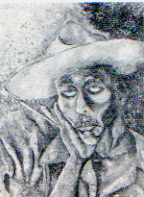
Although few details are known about this Henry Daley's life, his paintings many of which are self-portraits, provide insight into his short, poignant career as an artist. Even so, Daley's paintings are highly personalized depictions and for this reason, they should not be over romanticized.
Born in 1919 in Hope Bay, Daley was one of the first Jamaican students to benefit from the informal Saturday morning classes offered by artists such as Edna Manley and Koren der Harootian at the Institute of Jamaica. These classes had a workshop type atmosphere that allowed locals to paint alongside more accomplished artists, in the main expatriates. The aim was to nurture local art inspired by Jamaican culture rather Europe's art forms. Daley attended these workshops while still a young man. As an artisan by trade, doing small jobs that ranged from painting to plumbing, these classes offered him instruction and an opportunity for self-expression.
Classes were held at the Junior Centre close to the Institute's library that housed a small cache of modern art books. It was from these books that Daley gained exposure to art movements such as impressionism and post-impressionism, and developed an interest in Vincent Van Gogh whose artwork would have a marked influence on the style and content of his own work.
Daley came from humble circumstances, he was loner and something of a depressive and maybe it is for this reason that he seems to have identified with Vincent Van Gogh's life and work, so much so that much of his oeuvre appears to mirror that of the Dutch painter. In the same way that Van Gogh took to painting landscapes and sunflowers typical of the southern France, Daley focused almost exclusively on Jamaican vistas, flora and fauna and in particular its trees. To each of these scenes he brought freedom of expression and a style that seemed to speak of the challenges of his own life. His trees are strong rooted forms, gnarled and muscular, alive but agonisingly twisted. His landscapes have the same poetic and haunting quality.
Daley's portraits tell us even more, particularly about his commitment to art and how that this would impact on his life as he struggled to live from his work. Like Van Gogh, he painted himself often in various scenarios, as the artist, the thinker, the petitioner each work giving us a little more insight into his personality. His paintings show us that he was a handsome man who became progressively gaunt as his circumstances deteriorated. His face becomes weathered and beaten, while his eyes, like that of a supplicant are regularly upturned, appealing to a higher source. At a time when, Jamaicans were only slowly coming to terms with their sense of self and black identities, Daley's images are profoundly frank and moving.
Writing about Daley, the Jamaican poet/historian Philip Sherlock wrote:
Hungry Belly restless talked
When he saw Daley buy
Paint and canvas for a picture
For a picture when a plumber had to live
But the painter was a seeking
For something that he couldn't tell about
That he knew inside himself he must search
And search and find
Past the questions and divisions
Past the doubtings and the troubles
Past the doors and rows of doors
In the same way that Van Gogh has been mythologised because of his peculiar vision and his early death, Daley too has been immortalized in Jamaican art circles because of his impoverished life and tragic death. It is said that in his melancholy state he ingested his own paints and it was their lead that poisoned him. It seems more likely however, that he died from tuberculosis after prolonged illness and exposure to fumes. Whatever his fate, although, lessaccomplished and with limited art materials Daley can be considered a Jamaican Van Gogh and its first expressionist.
